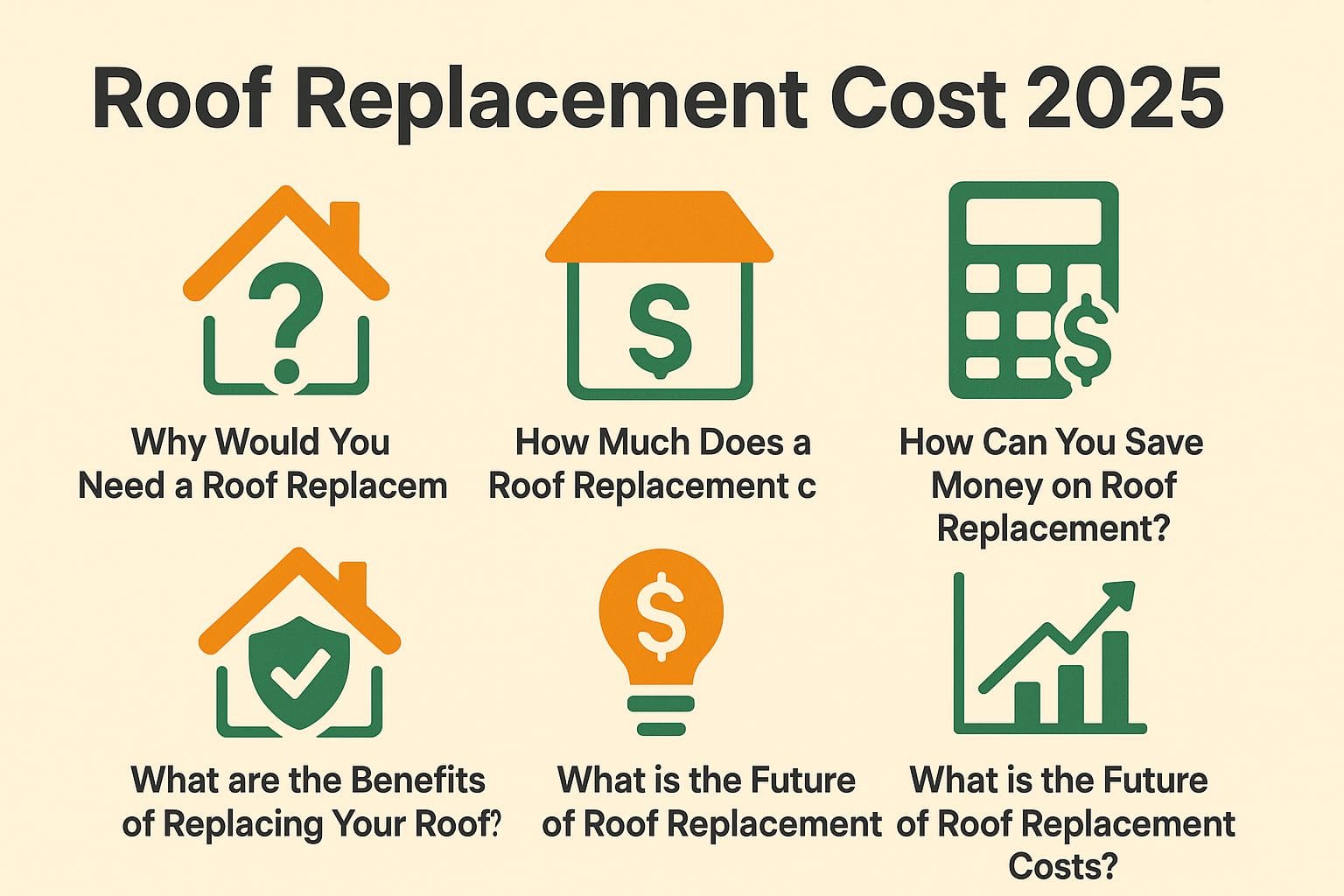Calculate Roof Replacement Cost in 2025
Depending on sq. ft, pitch, and type of roofing material used, the cost cost to replace a home roof ranges between $8,500 – $17,000. Find roof replacement near me! Check out this resource from the pros at 5Estimates.com to learn about roof replacement cost, find contractors, and save money by comparing quotes.

Is your roof showing signs of wear and tear? A roof replacement might be on the horizon.
This guide covers the essential reasons for considering a roof replacement and identifies the telltale signs that indicate it’s time for an upgrade.
It breaks down the costs involved, elements influencing those costs, and looks at the different benefits of replacing your roof.
Find practical tips to save money and find out about upcoming trends in roofing.
Read on to ensure your home remains safe, efficient, and beautiful.
Why Would You Need a Roof Replacement?
Replacing a roof is an important choice homeowners might need to make due to things like the roof’s condition and age, which can affect the home’s safety, look, and overall property evaluation.
Knowing when to start this costly but necessary home improvement project is key for keeping property value, planning and budgeting, and ensuring protection from weather conditions.
Common reasons for replacing a roof include:
- Visible damage impacting material durability
- Leaks requiring emergency repairs
- Weather-related harm affecting roof longevity
These issues can impact both home and business roofing systems. Talking to a qualified roofing contractor can offer helpful information about roof features and potential costs. If interested, homeowners can explore various factors affecting roof replacement costs to make informed decisions.
Roof Replacement Summary
| Section | Key Points |
|---|---|
| Signs You Need Roof Replacement | – Missing/damaged shingles – Leaks during rain – Roof sagging – Excessive granule loss – Stains/mold on ceilings/walls – Roof age & material-specific wear (e.g., rust on metal, warping on wood) – Regular inspections help with early detection & insurance claims |
| Roof Replacement Cost | – Cost depends on roof type, material, labor, and location – Permits, disposal, and contractor fees included – Financing can help manage expenses |
| Cost-Affecting Factors | – Roofing material (asphalt, metal, tile, etc.) – Location-based labor & code requirements – Contractor experience – Roof complexity & accessibility – Seasonal demand & inflation |
| Costs by Roof Type | – Asphalt shingles: $3,500–$8,000 – Metal roofing: Higher upfront, longer lifespan – Clay/Tile roofing: $10,000–$25,000 – Total range: $3,000–$15,000+ – Complexity (e.g., gables) increases cost |
| Benefits of Replacement | – Energy Efficiency: Insulation, ventilation, reflective & solar materials – Home Value: Better ROI, appeal to buyers – Curb Appeal: Aesthetic boost, modern options – Weather Protection: Enhanced safety & durability |
| Ways to Save Money | – Get Multiple Quotes: Compare labor, material, and project scope – Choose Affordable Materials: Asphalt for budget, metal for long-term value – Hire Reputable Contractor: Better workmanship, fewer issues – Use Tax Credits & Rebates: For energy-efficient upgrades |
What are the Signs that You Need a Roof Replacement?
Recognizing the signs that indicate a need for roof replacement can save homeowners from extensive damage and costly repairs in the long run. Common indicators include missing or damaged roof shingles, leaks during rain, and sagging areas on the roof.
Other signs are excessive granule loss from asphalt shingles, noticeable stains on ceilings and walls, or mold growth, which can affect the roofing materials and overall energy efficiency. Checking your roof regularly is important to spot problems early and find out if insurance can pay for replacement costs.
Along with these visible signs, homeowners should be mindful of age-related wear, as different roofing materials, such as wood, metal roofing, or tile, can exhibit unique deterioration patterns over time.
For instance, wood shingles may split or warp, while metal roofs could show rust or corrosion. It’s essential to monitor such conditions closely since early detection can greatly influence both the extent of repairs needed and potential insurance benefits.
Keeping detailed records of roof problems, past repairs, and routine checks can help with an insurance claim, making it easier to recover costs if a big problem occurs.
How Much Does a Roof Replacement Cost?
Knowing the cost of roof replacement is important for homeowners planning a roofing project, as many factors affect the total expense. The cost of a roof can vary greatly depending on the type, materials, labor expenses, and local rates. Therefore, obtaining accurate roofing estimates is essential. For a comprehensive understanding of these variables, consider exploring our deep dive into the factors affecting roof replacement costs.
Estimated Cost to Replace Roof by Material Type
| Material Type | Cost per Square Foot | Average Lifespan |
|---|---|---|
| Asphalt Shingles | $3.45 – $7.55 | 20 – 30 years |
| Metal Roofing | $6 – $30 | 40 – 70 years |
| Clay or Concrete Tiles | $11 – $26 | 50 – 100 years |
| Slate Roofing | $15 – $30 | 75 – 150 years |
| Wood Shingles/Shakes | $7 – $10 | 20 – 40 years |
A detailed cost breakdown includes fees for permits, disposal of old materials, and installation charges from roofing contractors. Considering financing options can help manage this long-term expense without straining the budget.
What Factors Affect the Cost of a Roof Replacement?
Various elements can greatly influence how much a roof replacement will cost, so homeowners should know these details before starting the work. The type of roofing materials chosen, whether asphalt shingles, metal roofing, or tile roofing, can alter the total expense due to varying prices and lifespans.
Geographical factors, like local rules and labor expenses, are very important, along with the contractor’s experience and accessibility of roofing permits. Construction inflation can also impact overall pricing, leading to fluctuations in estimated costs over time.
Specific materials often come with unique installation requirements that can further increase labor costs. Installing a metal roof might require special skills, which can increase the cost of hiring experienced workers.
Local building codes may require improving old structures, like better insulation or strengthening, which increases total costs. Different regions experience varying demand for roofing services, which can influence contractor pricing, especially during peak seasons.
Homeowners need to think about all these details to plan a realistic budget for their roof replacement project, helping them make choices that fit their financial goals and maximize return on investment.
How Much Does it Cost to Replace Different Types of Roofs?
The cost to replace different types of roofs can vary widely depending on the materials used and the specific requirements of residential or commercial roofing projects. For instance, while asphalt shingles are generally more affordable, metal roofing can offer better energy efficiency and longevity, justifying a higher upfront cost. A detailed comparison of roofing materials can help homeowners decide what best suits their budget and long-term needs. On average, costs can range from $3,000 to $15,000 or more, depending on the type of roof and the size of the area.
When looking at roofing choices, people should think about how difficult it is to install. Complex styles like gabled or hipped roofs might require more labor, which can raise costs.
For example, a simple asphalt shingle roof typically averages between $8,500 and $17,000, while more complex roofing styles, like clay tiles, can escalate costs to anywhere from $10,000 to $25,000.
Things like local wages and unique building features can influence the end price. Property owners should get multiple quotes to understand their investment based on their specific needs.
What are the Benefits of Replacing Your Roof?
Replacing your roof can greatly improve both the worth and function of your home. Although the upfront expense might be significant, installing a new roof can help your house use energy better, possibly lowering your utility bills.
It can also raise the price at which you can sell your home. Today’s roofing choices look better and have features that protect your home from bad weather and other risks, making homeowners feel safe. See also: Curb Appeal Boosters: Enhancing the Beauty of Your Home, which can further increase your property’s market value.

1. Improved Energy Efficiency
One of the significant benefits of replacing your roof is the improvement in energy efficiency, which can have a substantial impact on your home’s comfort and utility costs. New roofing systems often come equipped with advanced insulation and roof ventilation technologies designed to regulate temperature and reduce energy consumption.
These new features help keep heat inside during winter and reduce heat coming in during summer, creating a more consistent indoor temperature with integrated roofing technology.
Weather greatly affects energy use; homes in places with very hot or cold weather can especially benefit from high-quality roofing materials that either reflect sunlight or keep heat in, maximizing insulation and ventilation benefits.
Integrating eco-friendly roofing technologies, such as cool roofs made from reflective materials and solar shingles, can significantly lower energy bills while supporting a greener planet and helping with warranty options, aligning perfectly with the values of those who prioritize sustainability in their home improvements.
2. Increased Home Value
Installing a new roof can raise your home’s worth, making it a good choice if you intend to sell. New roofing materials can make a house look better, attracting potential buyers. Research shows that homes with new roofs often see a higher resale value, providing homeowners with a strong return on investment while ensuring that the property meets current building codes and standards.
Choosing top-notch roofing materials like slate or metal can improve a home’s appearance and lower maintenance expenses in the long run, especially when considering seasonal considerations.
On the other hand, less expensive choices might look worse and wear out faster, which can lower the resale value. Homebuyers are becoming more knowledgeable, usually searching for houses that look good and save energy.
When homeowners choose environmentally friendly materials, they make their homes better to live in now and more attractive to potential buyers later.
In the end, a new roof makes your home work better and increases its appeal in the real estate market, improving curb appeal.
3. Enhanced Curb Appeal
A new roof can greatly improve how your home looks from the outside, especially with updated roofing styles.
The roofing design plays a significant role in shaping first impressions, with options ranging from traditional asphalt shingles to sleek metal finishes that convey a contemporary edge.
Homeowners usually choose designs that fit well with their local area, like rough wood shakes for a country look or sleek tiles for a Mediterranean feel.
Popular materials such as solar shingles offer energy savings and combine usefulness with stylish design.
By choosing roofing materials that match the exterior colors and style of the home, property owners can improve the overall look and increase property value.
4. Better Protection from the Elements
Putting on a new roof shields your home from harsh weather and possible damage. Modern roofs include advanced features that make them safer, like better water drainage and materials that resist bad weather. This reduces the chance of leaks and damage, giving homeowners confidence that their investment is safe and their property is protected.
In comparison to traditional roofing options, contemporary materials like metal, asphalt shingles, and synthetic tiles provide varying levels of durability and resistance to extreme weather.
For instance, metal roofs can withstand high winds and heavy rain, while asphalt shingles may require more frequent maintenance due to different roof types and the need for roof assessment.
Each material has its own advantages, so homeowners should think about their area’s weather and their personal needs when choosing a new roof.
Selecting a quality roofing system enhances the look of a home and protects it from harsh weather.
How Can You Save Money on Roof Replacement?
Homeowners can save money on roof replacement by planning ahead, considering repair options, and making informed decisions.
Getting estimates from different roofing companies allows homeowners to compare prices, cost factors, and services to find the best deal. Understanding the various factors affecting roof replacement costs can further help in making a well-informed choice.
Talking with contractors might lead to savings, like getting discounts for jobs done in less busy times or when services are combined.
Looking into payment plans can also ease the initial upfront costs related to roofing work.

1. Get Multiple Quotes
Obtaining multiple quotes is essential when planning a roof replacement, as it allows homeowners to compare labor rates, construction quality, and materials while ensuring competitive pricing.
By reaching out to various roofing contractors, homeowners can gather different roofing estimates that reflect the scope of work required and the quality of materials offered. This helps find the best price and gives an advantage in talks with contractors to adjust costs.
Collecting a range of estimates enables individuals to better understand the typical price range in their area, which can be particularly beneficial in avoiding overcharging.
When discussing with contractors, clearly mention the specific materials you need, material selection, and any other choices you have to improve communication.
Discussing past projects or obtaining recommendations from friends can lead to a more informed contractor selection.
In the end, this detailed approach improves the roof replacement process and helps homeowners make informed choices about their costs.
2. Consider Different Materials
Looking at various roofing materials can greatly affect the price and performance of a roof replacement, so it’s important for homeowners to consider roofing trends and look into their choices.
While asphalt shingles may be more affordable upfront, investing in higher-quality materials like metal roofing or eco-friendly options can offer better energy efficiency and longevity, contributing to long-term savings. A thorough roofing materials comparison can help homeowners weigh their choices in terms of cost versus quality effectively.
Each material brings its unique advantages and drawbacks that go beyond mere installation costs.
For instance, while slate is renowned for its durability and aesthetic appeal, its hefty price tag, hidden costs, and challenging installation process can deter budget-conscious homeowners.
Conversely, eco-friendly roofing materials such as solar tiles or green roofs may offer long-term savings on energy bills over time, despite their initial expenditure being higher.
Homeowners must also consider local climate conditions, maintenance requirements, and potential resale value when analyzing the overall investment in roofing.
Knowing these points, including roof design and roof pitch, can help you choose something that suits your budget and quality needs.
3. Hire a Reputable Contractor
It’s important to hire a well-respected contractor for a roof replacement because their experience, including contractor experience, affects how well the roof is installed and how happy you are with the job.
Researching potential contractors by examining customer reviews and assessing their experience with various roofing technologies can help homeowners make informed decisions. A roofing contractor can provide specific advice based on the unique needs and situation of your house, making sure the work is done properly.
Homeowners should pay close attention to customer reviews, as they often highlight the contractor’s strengths and weaknesses, shedding light on past projects.
This feedback shows the contractor’s trustworthiness and skill in their work. It also explains how they handle any problems that come up during the job, affecting the overall ROI.
Picking a contractor who knows different roofing systems can greatly improve the project’s result because they can foresee problems and offer the right solutions.
In the end, the right contractor will provide a good roof and make sure the process is smooth and easy.
4. Take Advantage of Tax Credits and Rebates
Utilizing tax discounts and refunds can significantly lower the cost of getting a new roof, helping homeowners handle the financial burden, especially with payment plans available.
Many local governments and organizations provide benefits for homeowners who choose energy-saving roofing materials. These materials can improve a home’s energy efficiency and lower utility bills over time. Knowing what you need for roofing permits and if you can get financial help can save you money on your roofing project.
These programs promote environmentally friendly choices, urging homeowners to choose roofing materials that lower expenses and are good for the environment.
Homeowners should learn about local regulations for roofing work, including permits, as these can affect material or design choices.
These rules can affect both project schedules and the financing choices, so it’s important to plan carefully.
By handling these aspects well, residents can make the most of their investment and fully benefit from the financial incentives they can access.
What Will Roof Replacement Costs Be in the Coming Years?
The price of getting a new roof in the next few years, such as in 2025, will be affected by things like rising building costs, higher pay for workers, and changes in roofing technology that affect how much you pay.
As the need for top-quality roofing materials grows, economic factors and conditions will significantly impact total costs.
Homeowners should stay updated on market changes and new technologies to better predict upcoming costs related to roof replacement.

1. Impact of Inflation
Inflation significantly increases roof replacement costs by raising the prices of materials, labor market rates, and labor, which homeowners need to account for when planning a roofing project.
As construction inflation rises, the cost of roofing materials such as asphalt shingles and metal roofing is likely to increase, leading to higher overall price quotes from contractors. It’s important for homeowners to know economic factors to plan and control roofing costs well.
In recent years, fluctuations in the economy have further complicated the roofing market, wherein homeowners might find themselves facing steep increases in both material costs and workforce charges.
When there aren’t enough trained workers, the need for experienced roofers increases, which can raise the cost of installation services. Problems in global supply chains can make things worse, leading to delays and shortages of some materials.
With these rising costs, homeowners should watch current pricing trends and consider options like financing or seasonal discounts to make decisions that fit their budgets and home insurance coverage.
2. Advancements in Roofing Materials
New developments in roofing materials provide affordable and long-lasting options that can improve how a home functions and looks. Advances in roofing technology have created environmentally friendly options that support sustainability and often offer long-term savings. Knowing how to balance cost and quality when choosing roofing materials will be very important for decisions about roof replacement later on.
With a growing emphasis on environmental stewardship, homeowners are increasingly attracted to materials such as recycled metal, solar shingles, and green roofs.
These modern solutions often reduce energy consumption, improve insulation, and promote a healthier living environment.
While the initial investment may appear higher, the lifespan and energy savings associated with these materials can lead to substantial savings over time.
As more people want eco-friendly roofing, prices might drop and the quality might get better, making these choices more attractive for homeowners planning their new roofing work.
3. Changes in Labor Costs
Variations in labor costs significantly affect roof replacement prices, especially as the construction industry adjusts to different economic situations. Fluctuations in labor rates can directly impact the overall cost of roofing projects, depending on the contractor’s experience and regional pricing structures. Homeowners should monitor local labor cost trends to forecast and budget precisely for roofing expenses.
To understand how labor costs affect project expenses, you need to know how wages for skilled workers differ across locations. A contractor with a lot of experience might ask for more money, but this usually means better work and fewer expensive errors.
Prices in different areas can change a lot because of how much people want something, what materials are available, and local rules. Make sure to look into the options carefully and obtain multiple quotes. By grasping these factors, homeowners can make informed decisions, ensuring they select the best services while remaining within budget.
4. Impact of Climate Change on Roofing Needs
Climate change is increasingly influencing roofing needs as extreme weather events become more frequent and intense, necessitating the use of durable and energy-efficient roofing materials. Homeowners are now more aware of the importance of roof ventilation and other roofing systems that can withstand harsh weather conditions while maintaining energy efficiency. Choosing the correct materials and design is important to make sure roofs last long and work well in different weather conditions.
Lately, people have realized that spending more on good residential roofing makes homes last longer, reduces energy costs, and increases indoor comfort. Investing in quality materials also adds to the roof lifespan.
Roofing solutions made to save energy, like reflective materials and good insulation, help lower heat absorption, which reduces the need for heating and cooling systems. This can significantly increase the ROI of your investment.
Effective roof ventilation can help regulate temperature and moisture levels, preventing issues like mold growth and structural damage, which may require costly roof repair.
Choosing the right roofing is important for shielding homes from climate impact and supporting sustainability. Think about where you are, the design of the building, and how long the work will take when planning improvements. Regular roof checks and knowing the cost per square foot are important, as is knowing the warranties for the materials used.
About the Author
Mark Ellington is a home improvement expert and CEO of a $50M remodeling firm. With 20+ years of experience and a degree in Construction Management from Purdue, he shares practical renovation tips, pricing insights, and contractor advice at 5Estimates.com to help homeowners make smart, informed decisions on their projects.





